Abstract
The historical loss of natural wetlands in Romania is significant. The building of lakes, ponds, and dams has compensated for some of these losses, as was the case in the study area, the artificial wetlands designated as the Natura 2000 (special protection area, SPA) and Ramsar sites. In this context, to evaluate the conservation status of colonial waterbirds (cormorants, herons, and egrets), we analyzed actual distributions, habitat selection, features, and population sizes. Standardized counting of colonial species was used, supplemented by nest counting and colony-area estimation during winter, and drone footage. All species and their colonies were built in artificial or anthropically influenced habitats. Concerning distribution and population sizes, Phalacrocorax carbo and Microcarbo pygmeus were found to nest only in central Romania. The pair numbers of Ardea alba, Ardea purpurea, Ardea cinerea, and Nycticorax nycticorax in the area exceeded 1% of the national minimum breeding population. There was a statistically significant positive trend of breeding populations for Ardea alba, Nycticorax nycticorax, and Egretta garzetta. In conclusion, these artificial wetlands offer optimal breeding conditions for a relatively large diversity of colonial bird species over areas that are not very large.
1. Introduction
Historically, biodiversity, including waterbirds, in Romania has suffered significant losses of populations and habitats, especially through drainage and dam works mainly along the Danube floodplain, where over 530,000 hectares of wetlands with diverse habitats have been transformed or lost [1]. The creation of artificial wetlands such as fish farms, lakes, and reservoirs with various functions has partially compensated for these losses, and bird populations adapted to conditions which are more or less different from natural ones [2]. This was found to be the case for the colonial birds in this study, with some being new breeding species for the reference area (Transylvania or the Brașov depression). Integrated management can be performed within fish farms, targeting the interests of both aquaculture and biodiversity conservation.
The main study aim was the inventory and monitoring of eight colonial waterbird species concerning the actual occurrence, distribution, habitat selection, colony characteristics and relation with human constructions, and population size in the study area, all in interdependence with aquaculture management and other human-related activities over a decade (2010–2020). Distribution and population size were compared with those on the regional (central Romania, Transylvania, or inside the Carpathian chain) and national levels to establish the importance of the study area. This research focused on relevant artificial wetlands southeast of Transylvania: Dumbrăviţa (including the Dumbrăvița fishing-complex Ramsar site) and the Rotbav Natura 2000 Site, special protection area (SPA; ROSPA0037 Dumbrăviţa-Rotbav-Măgura Codlei).
These aspects are relevant for reasons such as the extension of breeding areas for some species; the existence or creation of new or recent wetlands such as fish farms, lakes, gravel pits, and dams; and the lack of or poor knowledge on the distribution, population size, and their trends over various periods on the local, regional, or national levels [3,4,5,6]. In addition, these data can be used in conservation and sustainable and integrated management, including the assessment of species conservation status and preparing conservation measures within the future Natura 2000 site-management plan (2021–2026).
2. Materials and Methods
2.1. Study Area
Research was carried out on two main artificial wetlands within the Dumbrăvița–Rotbav–Măgura Codlei Natura 2000 site (N 45°43′10″ and E 25°24′38″). These are situated at the internal curvature of the Carpathians, a territory in central Romania named Transylvania province (Figure 1). The total area of Transylvania is 57,000 km². The study area is an artificial wetland and one of the most important concentration sites for water birds within Transylvania (Figure 2). The Dumbrăviţa fishing complex covers an area of over 450 ha, and is a large system of fishponds and reservoirs. It was also designated as the Ramsar site—wetland of international importance (the only such site in Transylvania) with the proposal to expand the site to 2282 ha (including both wetlands and the adjacent areas). The Rotbav lakes and fishponds cover over 230 ha. There, there is another anthropically influenced wetland: a marsh covered by emergent vegetation resulting from the clogging of drainage channels. The marsh was formed over 30 years ago by abandoning the works of unclogging the canals and a nonfunctioning water-pumping station. The main human activities in the whole wetland area are aquaculture and angling. Asian fish species are mainly cultivated, such as Hypophthalmichthys nobilis, Hypophthalmichthys molitrix, and Ctenopharyngodon idella, but also Eurasian species Cyprinus carpio. In addition, there are other small fish, some invasive, such as Pseudorasbora parva, which are food for many fish-eating birds (personal observation). Without a qualitative and quantitative study of the food available to birds in the concerned area, the appearance, maintenance, and growth of bird populations can be attributed to the existence of various and rich trophic sources in the conditions of artificial foraging and large yields per hectare (more than 1–1.5 t/ha) of farmed fish (Crizbășan D., general manager of the fish farm, verbal communication).
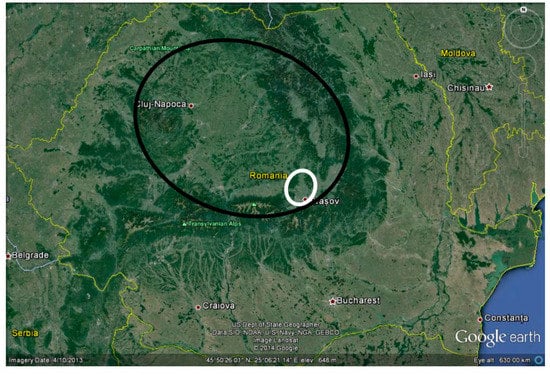
Figure 1.
Study area. White circle (Brașov depression), part of Transylvania province; black oval, Romania.
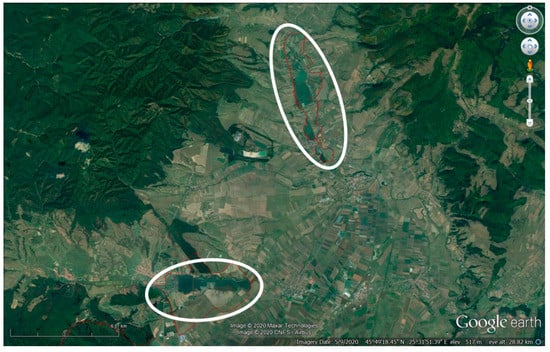
Figure 2.
Detail of study area. Dumbrăvița (bottom) and Rotbav wetlands (white ovals) within ROSPA0037 (red border).
Depending on the type of Ramsar site wetland, the main habitats within the study area were permanent freshwater marshes (Tp), freshwater-tree-dominated wetlands (Xf), aquaculture ponds, reservoirs, and seasonal/intermittent freshwater marshes (Ts) [7]. These kinds of artificial wetlands are recognized as very important or even “key” sites for many vulnerable, rare, or endangered bird species; because of that, Dumbrăviţa and Rotbav were designated as Important Bird Areas [8]. The Natura 2000 Site has an official management plan comprising several concrete measures for the long-term conservation and maintenance of bird species and populations in balance with sustainable fish farming.
Transylvania has wetlands, especially in its central and southern parts, represented mainly by artificial types such as lakes, reservoirs, and fishponds. We chose the two areas for study considering their importance, recognized on the European and international level, being the only Ramsar site in Transylvania. Studies and monitoring have taken place here for 25 years for some groups of bird species. The number of colonies and component species was also a criterion in this regard.
2.2. Methods
For bird, nest, and colony identification, only standardized, noninvasive methods were applied. Concerning the monitoring of species populations/colonies, one main method was used [9]: counting/monitoring colonial species of herons and cormorants. This method is based on the estimation of apparently occupied nests, in our case, by choosing observation points which avoided disturbing the colony but from where the entire colony could best be observed. All entrances and exits of the birds from the colony were noted, and observable nests were counted. Thus, we counted and noted the breeding pairs. The relative position of the colonies was drawn on maps and then compared with that identified by drone footage and satellite images (Google Earth). Several successive observations during the breeding period (1 April–31 July) were made. To complete the counting of the nests and to precisely establish the position of the colonies and their surface, they were accessed during winter on ice (using a global positioning system (GPS) with points and track functions).
Counting/estimation of breeding pairs was also done by filming the colonies with a drone. We used a DJI Phantom 4 Pro drone with a mobile camera and a noise level of 81 dB. The drone was flown out at 20–30 m from the reedbeds or woody vegetation. The drone’s flight comprised one pass over the colonies, usually lasting 10–15 min. The only observed effects on the birds in the colony were their attention to the drone and, at most, the lifting of the adults from the nest without leaving it. We also estimated breeding populations for all waterbirds using the point-count transect method of 2 × 2 squares [9]. Binoculars (10 × 50), a scope (×20–60), and a professional camera were used. The monitoring period was 2010–2020.
To calculate different types of distances and the colony areas, Google Earth was used with specific tools. We calculated some measurable elements of the colonies, i.e., the total or smallest areas occupied by the colonies during the monitoring period, and the nearest distance from the edge of the colony to terrestrial habitats—in our case, to dams, roads, or buildings. Regarding the total area occupied by the colonies, we separately overlapped and summed the areas for the monitoring period of the two areas—Dumbrăvița and Rotbav. The minimal area occupied by various colonies (e.g., built on islands) was also calculated.
2.3. Statistical Analysis
Linear-regression analysis was applied to investigate if there was a significant relation between colony area and breeding pairs or the nearest distance to the dam, but to also test if there was a significant population trend over the last 10 years for different species or on the colony level. One-way ANOVA was performed to test if the substrate nest types affected the population trend of two species, Nycticorax nycticorax and Egretta garzetta. All statistical analyses was done using STATISTICA 10 (StatSoft 2012, Inc., Tulsa, OK, USA).
3. Results
A total of eight colonial waterbird species were recorded within the study area during the observation period: great cormorant (Phalacrocorax carbo), pygmy cormorant (Microcarbo pygmaeus), gray heron (Ardea cinerea), purple heron (Ardea purpurea), great white egret (Ardea alba), little egret (Egretta garzetta), black-crowned night heron (Nycticorax nycticorax) and squacco heron (Ardeola ralloides). In terms of conservation, six of the species are included in Annex I of the Birds Directive (2009/147/EC), as they are species of community interest (Table 1).

Table 1.
Breeding habitats and nest-building substrates.
3.1. Colony Types
Two types of colonies were formed:
- —
- Monospecific, for the following species: Phalacrocorax carbo, Ardea cinerea, Ardea purpurea, and Ardea alba. All of them can also form mixed colonies, and some can also breed in isolated pairs (Ardea cinerea, Ardea purpurea, Ardea alba).
- —
- Only mixed for the following species: Microcarbo pygmaeus, Egretta garzetta, Nycticorax nycticorax, and Ardeola ralloides. The most stable type of mixed colony was formed by all four of these species, with Ardea cinerea at Dumbrăvița (since 2012) and the other three species at Rotbav (since 2016).
3.2. Breeding Habitat Types/Nest Locations
Regarding the habitats where the colonies were located, there were three major types: reedbed, shrubs or trees in wetlands, and artificial land islands with various woody species (Table 1). The first habitat was, according to CORINE classification 53.11, common reed (Phragmites australis) bed, and to EUNIS classification C3.21, Phragmites australis beds. In some cases, two of the colonial species, Ardea cinerea and A. purpurea, also bred inside reedmace. Thus, the habitat according to CORINE was 53.13, i.e., reedmace (Typha) beds, and, according to EUNIS, was C3.231/232 Typha latifolia/T. angustifolia beds. For colonies inside scrubs and trees, the most relevant CORINE habitat was 44.921, i.e., grey willow scrub; for EUNIS, it was F9.213, i.e., intra-Carpathian grey willow carrs, where the dominant woody species is Salix cinerea [11]. One of the oldest monospecific colonies (Ardea cinerea) was built in a mature oak forest (Quercus robur) near the Dumbrăvița wetland, but it has been extinct since 2011. In this case, it was a colony formed in a terrestrial habitat (nonwetland). We assumed that the birds that had formed this colony occupied fish-farm wetlands to breed in the following years.
Concerning the construction substrate of the nests, there are two distinct situations: emerged vegetation (reed, reedmace) and woody vegetation. In woody vegetation, nests are located mainly on Salix cinerea, but also on S. fragilis and S. babylonica. In addition to willows, other species were used in one location, such as Prunus cerasifera and Sambucus nigra. In the first two years of the decade (2010–2011), a colony of Ardea cinerea bred in mature oaks (Quercus robur) from a pure mature-oak forest. The only species that built nests exclusively on emergent vegetation (especially on reedbed) was Ardea purpurea, and the only species that built their nests only on woody vegetation were Phalacrocorax carbo and Microcarbo pygmaeus (Table 1).
Regarding the frequency of use of the two major habitat types, as a substrate for breeding by the mixed colony (Egretta garzetta, Nycticorax nycticorax, Ardeola ralloides), woody vegetation was used (100%) in Dumbrăvița in all years, while the reedbed was used only in 3 years (37.5%).
3.3. Colony Distribution within Study Area
Six fishponds and lakes were used as breeding sites by the studied colonies (Figure 3, Figure 4, Figure 5, Figure 6, Figure 7 and Figure 8). The area of he six artificial water bodies had a range of 36–44 ha, with an average of 39 ha, but not all species and types of colonies used all these lakes and ponds. In addition, three of the species bred colonially in a marsh formed between drainage channels, in flooded reeds (Figure 4). The positioning of the colonies may differ from year to year, with the birds either being able to keep their location for a number of years or changing it to somewhere else in the same basin or elsewhere.
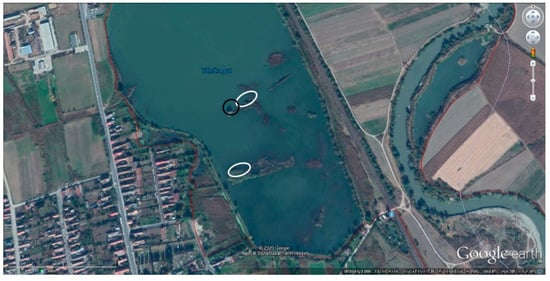
Figure 3.
Colony location on Lake 3 Rotbav, 2010–2020 (black circle, Phalacrocorax carbo; white oval, mixed consisting of Nycticorax nycticorax, Egretta garzetta, Ardeola ralloides).
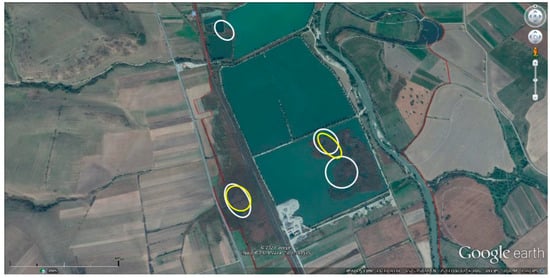
Figure 4.
Colony location on fishponds and in marsh from Rotbav, 2010–2020 (yellow oval, Ardea alba; white oval, A. cinerea, A. purpurea).
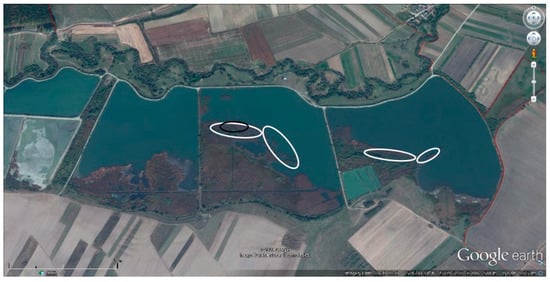
Figure 5.
Colony location on fishponds from Dumbrăvița, 2010–2020 (black oval, Phalacrocorax carbo; white oval, mixed, consisting of Microcarbo pygmaeus, Ardea cinerea, Nycticorax nycticorax, Egretta garzetta, and Ardeola ralloides).
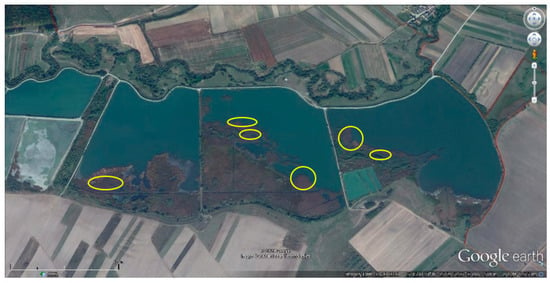
Figure 6.
Colony location on fishponds from Dumbrăvița, 2010–2020 (yellow oval/circle, Ardea alba).
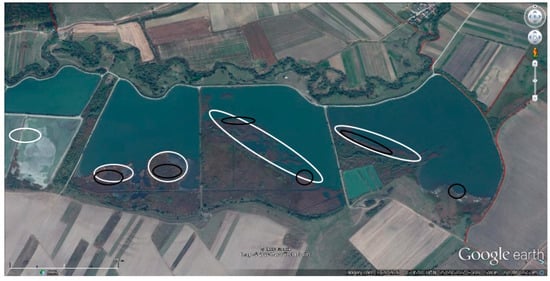
Figure 7.
Colony location on fishponds from Dumbrăvița, 2010–2020 (white oval, A. cinerea; black oval, A. purpurea).
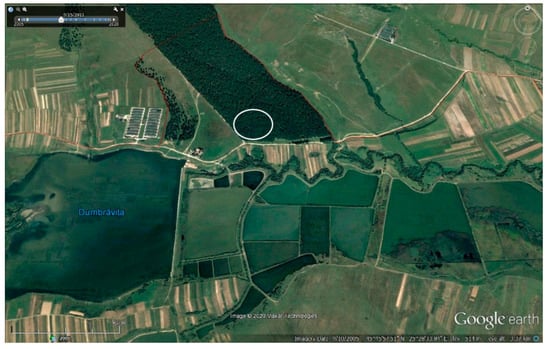
Figure 8.
Location of old Ardea cinerea colony (white oval) within mature-oak (Quercus robur) forest from Dumbrăvița; 2011 was the last year when this species bred within the forest.
3.4. Colony Characteristics/Elements
3.4.1. Areas Occupied by Colonies during Monitoring Period
Within the Rotbav area, the total area occupied by the mixed colony (Nycticorax nycticorax, Egretta garzetta, Ardeola ralloides) during the monitoring period (5 years) was 1380 m2. This represents 62% of the total potential nesting area (islands with woody vegetation). The total area of the mixed colony from Dumbrăvița (Nycticorax nycticorax, Egretta garzetta, Ardeola ralloides, Microcarbo pygmaeus) amounted to 12,080 m2 (1.2 ha) during 9 years. Of this total area, the colony formed only on woody vegetation totaled 7560 m2, which means that 62.6% of the total area was occupied and, for the one formed on reeds, 4520 m2 (37.4% of the total area occupied). The area occupied by the colony on reeds represents 3.5% of the total area of reeds and 23.8% of the total area of reed islands and peninsulas. Regarding Ardea alba at Dumbrăvița, two breeding nuclei (grouping of nests of over 70% of the total nests in that year) totaled 7000 m2, the smaller of the two being 1500 m2 (formed by 12 nesting pairs). Concerning the minimal area occupied by an isolated colony (island type), for Rotbav, it was only 320 m2, and for Dumbrăvița (reedbed island) 1350 m2. The total areas occupied by the mixed colony at Dumbrăvița therefore mostly overlapped with woody vegetation. Ardea alba, A. cinerea, and A. purpurea could also form fairly small colonies in terms of area, even if some pairs bred isolated or in groups of 2–3 nests.
3.4.2. Nearest Distance from Colony Edge to Terrestrial Habitats and Human Constructions (Dams, Roads, or Buildings)
The smallest distances between the edge of the colonies and dams were of the order of tens of meters, and even distances to the nearest, very crowded road were around 100 m. Two of the breeding colonies in the Rotbav marsh were also built at a distance of just over 200 m from an active and noisy ballast- and cement-processing plant (Table 2).

Table 2.
Nearest distance (m) from colony edge to terrestrial habitats and human constructions.
The breeding pairs increased significantly with the increase in colony area for the Dumbrăvița mixed colony, formed by Egretta garzetta, Nycticorax nycticorax, and Ardeola ralloides (p < 0.05, Figure 9); for the Rotbav mixed colony (same species as those of the Dumbrăvița mixed colony), we did not find significant correlation between breeding pairs and occupied area (p > 0.05, Figure 9), most probably due to the very low number of samples (n = 5) and very weak variability within the colony surface variable.
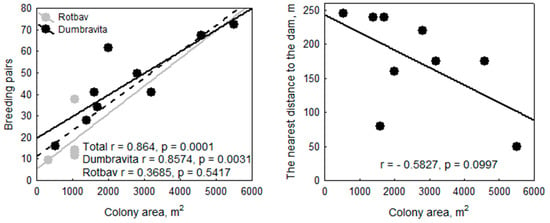
Figure 9.
Relation between breeding pairs and colony area separated by (left) both colonies and (right) between nearest distance to dam and colony area.
Regarding the relation between the nearest distance to the dam and the Dumbrăvița mixed colony area formed by Egretta garzetta, Nycticorax nycticorax, Ardeola ralloides, we found negative correlation (r = −0.58, Figure 9, right), but this was only marginally significant (p = 0.099).
No effect of substrate-type change on the population trend could be detected for the two species of Nycticorax nycticorax and Egretta garzetta (Figure 10, p > 0.05, one-way ANOVA, F-test).
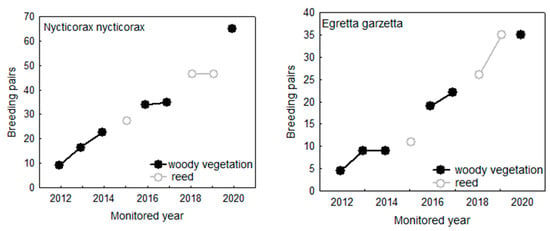
Figure 10.
Influence of substrate type (woody vegetation vs. reed) on (left) Nycticorax nycticorax and (right) Egretta garzetta population trends.
3.5. Population Size/Number of Pairs and Trends
The largest number of pairs belonged to the Ardea cinerea and Nycticorax nycticorax species, and the fewest pairs to the Ardeola ralloides, Phalacrocorax carbo, and Microcarbo pygmaeus species. Although the breeding populations of the analyzed species in the studied area were much smaller than those of the national ones, for some species, the minimal or maximal estimated number was equal to or higher than 1% compared to the national one, especially for the 2008–2013 period (Table 3).

Table 3.
Population size of analyzed species within study area and their comparison with the national population [5,6].
A significant increase in breeding pairs over the last 10 years was found for four species (Ardea alba, Egretta garzetta, Nycticorax nycticorax, and Ardeola ralloides; p < 0.001, Figure 11), but no significant tendency in the last decade was confirmed for the two other species (Ardea purpurea and Microcarbo pygmaeus; p > 0.05, Figure 11).
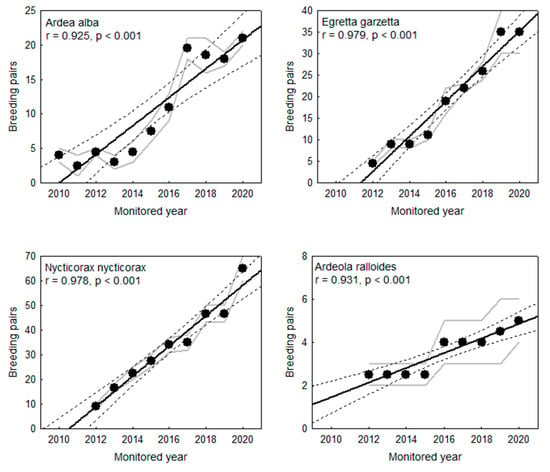
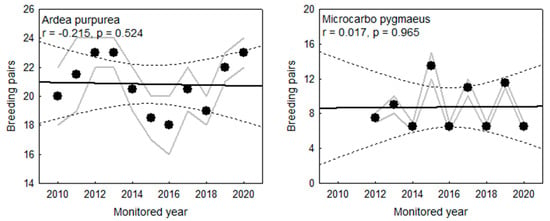
Figure 11.
Population trend over last 10 years for Ardea alba, Egretta garzetta, Nycticorax nycticorax, Ardeola ralloides, Ardea purpurea, and Microcarbo pygmaeus. Linear regression (continuous black line) and associated 95% confidence interval (dotted black line). Gray lines represent minimal and maximal estimated breeding pairs in the field.
At the mixed-colony level formed by Egretta garzetta, Nycticorax nycticorax, and Ardeola ralloides, Figure 12 shows the population trends over the last decade. In the Dumbrăvița mixed colony, the breeding pairs increased significantly in the last 10 years; for the Rotbav colony, this tendency was confirmed but not significantly tested.
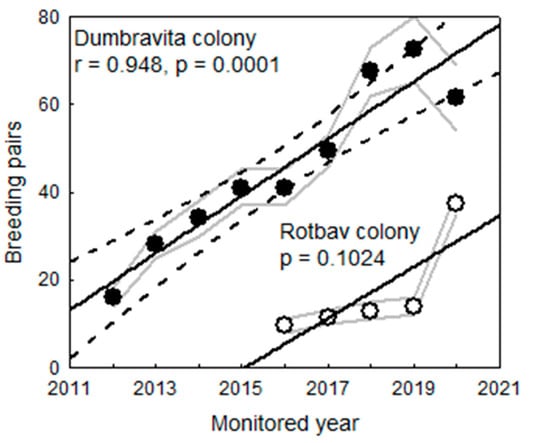
Figure 12.
Population trends over the last 10 years.
4. Discussion
4.1. Use of Habitat Type or Nesting Location in Relation to Natural and Human Factors
Within the species range, heronries can be located in wetlands or terrestrial habitats. In dry forests, heronries can be located in natural habitats (e.g., oak [12]) or in various plantations, such as pine [13], false acacia groves, or poplar [14]. In wetlands, heronries can be located in woody vegetation, such as alder and willow [14], tamarisks, alder and willow [15], various willow species [16], or on reedbeds [14,16,17,18,19,20,21]. Nycticorax nycticorax, Egretta garzetta, and Ardeola ralloides are known to breed only on woody vegetation within central Romania–Transylvania [4,12,13] (Daróczi Sz., David A., Sándor D. A., Szabó Z., Stermin A., Kósa F., verbal communication), but in recent years, Nycticorax nycticorax has started breeding on reedbeds at the Sânpaul fishponds (Harghita county, 35 km from our area) (dr. Szabo J., verbal communication). Therefore, the breeding of Egretta garzetta and Ardeola ralloides at Dumbrăvița reeds is a unique case for Transylvania, and Nycticorax nycticorax rarely nests in reeds in the center of the country. Concerning the relation between the mixed colonies’ occupied area and population size, it is normal for Dumbrăvița to increase the occupied area of the colony with the increase in breeding pairs, especially if the reedbed is also used. In this case, the colony extends horizontally, compared to the woody vegetation where the extension can be done vertically.
For reed-breeding species such as Ardea purpurea, water depth is a major factor determining reedbed occupancy [17,18]. Sometimes, the use of a habitat type or nesting location is forced by various factors, such as insufficient or sudden fluctuations of water level [16]. Reed-nesting herons may select flooded reedbeds for breeding, which reduce the access of terrestrial predators [12,22]. The water level in all ponds within the studied artificial wetlands is artificially adjusted according to the needs of the aquaculture management, and, during April–July in normal conditions, it is approximately 60–80 cm in the reedbeds with colonies of Ardea purpurea and A. alba. In some years (e.g., 2019 and 2020), when the water level was 0–10 cm in the reeds during April–May on the main breeding pond at Rotbav (12 ha of reedbed), these species had to form colonies in the flooded marsh in the vicinity (Figure 4). At the same time, the decrease by over 25–30 cm in water level in a pond from Dumbrăvița (e.g., April 2018) facilitated the access of wild boar Sus scrofa. This led to the relocation of the Ardea alba colony formed in the reeds to another pond. The new colony was built on Salix with other species of herons and cormorants, and it was the only breeding case of great white egret on woody species in the study area. For the mixed colony on the woody vegetation of the islands, water level may be variable or even zero in the nesting willows (e.g., in 2020 in the Rotbav colony, there was no water in April–May, but the island was surrounded by water, with no access land). Such islands also provide nesting opportunities by protecting birds from terrestrial predators [23,24]. For example, in the Czech Republic, artificial pond islands seem to be essential for the survival of several waterbird species [24]. A similar case, however, regarding the increase in water level can lead to the flooding of the nests and thus to the abandonment of the nesting place (e.g., in the end of April 2020, a colony of Ardea purpurea in formation on a reedbed within a main pond from Dumbrăvița left the location after the water level increased by 20–30 cm). However, in the two studied wetlands, there are sufficient areas for breeding in good conditions for a constant or increasing number of pairs. Thus, for Ardea purpurea and A. alba, there are currently about 26 ha of flooded reedbeds (including reedmace) as a potential habitat for these species. The species that form mixed colonies (herons, egrets), in addition to the surface occupied by woody vegetation, can also use part of the flooded reeds, which happened in 3 years of the decade. Moreover, the management plan of the Natura 2000 site provides for the maintenance of a sufficient water level in the ponds preferred by the colonies during the breeding season. This measure favors both fishery management and the life of fish raised by a high level of water in the warm period of the year, as well as all species of breeding birds in various types of flooded vegetation that require sufficient water during nesting. In addition, the plan requires the conservation of the whole habitat consisting of reedbeds and willow clumps [25]. We are, therefore, talking about the sustainable management of the aquatic resource and the entire artificial wetland.
4.2. Nearest Distance from Colony Edge to Terrestrial Habitats and Human Contructions
The nearest distance from the edge of the colonies to terrestrial habitats could reflect predator accessibility to the colonies [17,26,27]. At least in the case of the Dumbrăvița fish farm, potential terrestrial predators (e.g., wild boars) can penetrate the vegetation of fishponds anywhere, and there is a network of paths on some of them (own observations). Thus, the distance from the colony to the dams is probably not important in protecting the nests from wild boars. At the same time, it is relevant that the whole area is subject to anthropogenic activities and pressure (aquaculture, angling, car and rail traffic, human habitation, leisure activities). Considering the calculated distances, there is a fairly high degree of tolerance of the colonies to humans and some human activities.
Regarding the relation between the nearest distance to the dam and the Dumbrăvița mixed colony area formed by Egretta garzetta, Nycticorax nycticorax, and Ardeola ralloides, the negative correlation that we found can be explained by the fact that, with its expansion, the colony approaches at least one of the dams.
Below are some general considerations on the trend of breeding populations. For none of the species was there an obvious negative trend in nesting population during the 10-year study period. The causes of fluctuations in the annual number of pairs in the case of some species, such as Microcarbo pygmaeus and Ardea purpurea, are not known; these may be local, but also may not be related to the studied area. Maintaining or significantly increasing the number of pairs depending on the species is due to habitat conditions and food supply. Subsequent studies can show to what extent the type and amount of food available on the fish farm and its surroundings influence the presence and dynamics of waterbird breeding populations. Until then, we can only assume that, at least inside the fish ponds, there is a rich trophic source that can maintain a certain number of pairs of colonial waterbirds, such as cormorants, herons, and egrets. Commercial fish in particular reach stocks that are much higher than those in natural ecosystems (1–1.5 t/ha). At the same time, fish from all fattening ponds are fed throughout the warm season, and some of the food is probably eaten by economically unimportant wild fish upon which birds feed (e.g., Pseudorasbora parva, Carassius gibelio).
4.3. Species Occurrence, and Their Distribution and Population Size
These aspects are discussed in comparison with the reference area (Transylvania) and with the situation on the national level. Regarding the distribution of species, data published in monographic books and atlases were considered, [3,4,28,29,30,31,32]. The most recent and official publication of national breeding and nonbreeding birds is the atlas of bird species of community interest in Romania [5]. This atlas presents distribution maps of species using grids (squares) of 10 × 10 km as in other monographic books [4]. The assessed population size for each of the eight species is compared with the national one according to two official and current sources [5,6]. In Transylvania, some former or recent heronries are known. One of the largest has been known since 1986 with three species (Nycticorax nycticorax, Ardea cinerea, and Egretta garzetta). Nycticorax nycticorax was most abundant in 1995, with about 300 pairs, compared with only 25 pairs of Ardea cinerea [13,33]. Another colony where Nycticorax nycticorax was also the dominant breeding species is located in the Iernut-Cipău fishponds [34]. Without making a comparison, recent data (2015–2018) from the largest natural wetland in Romania and Europe, the Danube Delta Biosphere Reserve, showed higher or lower fluctuations in the considered colonial species; the only species with an obvious growth trend was Nycticorax nycticorax [35].
4.3.1. Great Cormorant (Phalacrocorax carbo)
Our observations are the first published evidence of Phalacrocorax carbo breeding in Transylvania [3,5,28,29,30,31,32], but there is an observation regarding this from 2000–2001 in a colony on the Mureș river at Acmariu (N 45.955271, E 23.382908), i.e., 8–14 pairs (Sándor D.A., verbal communication). Moreover, the great cormorant does not currently appear as a breeding species anywhere within the interior of the Carpathian chain [5], but there are reports of it as a nesting species (Bărbos L., verbal communication) within a mixed colony at Suplacu de Barcău, Bihor county.
4.3.2. Pygmy Cormorant (Microcarbo pygmaeus)
So far, the studied area is the only known one in Transylvania where Microcarbo pygmaeus nests [5,36]. This location is also among the few breeding places of the pygmy cormorant inside the Carpathian chain.
4.3.3. Grey Heron (Ardea cinerea)
In the central part of Romania (Transylvania) there are another 9 squares of distribution of Ardea cinerea compared to that of the studied area [5]. Munteanu et al. [4] present it as a breeding species in two locations in Transylvania. The Grey Heron bred in a monospecific colony in an oak forest from Dumbrăvița, and in 2004, breeding began in the emergent vegetation from a fish farm. It is important to point out that the breeding population in our study area exceeds 1% of the national minimum population.
4.3.4. Purple Heron (Ardea purpurea)
In central Romania, Ardea purpurea was found in 4 other squares of distribution in addition to our locations. In 6 other squares, the species breeds inside the Carpathian chain [5]. According to [4], in addition to our area, there is only one breeding location in Transylvania. From a breeding-population point of view, it is clear that the breeding pairs there exceeded 1% of the minimal or maximal values of the breeding population in Romania for the period of 2008–2013. The values that we found were also higher than 1% of the minimal population in 2013–2018. The breeding population of the species in the studied area was close to the threshold (C6—30 pairs) used in Romania as a criterion for selecting the area as an Important Birds Area [8].
4.3.5. Black-Crowned Night Heron (Nycticorax nycticorax)
In central Romania, Nycticorax nycticorax was found in 3 other squares of distribution in addition to our locations. The latest data also showed 9 squares inside the Carpathian chain [5]. Another monographic paper [4] presented only three locations of known, current, and recent colonies in Transylvania. The breeding population in recent years in our study area exceeded 1% of the national minimal population.
4.3.6. Squacco Heron (Ardeola ralloides)
In central Romania, Ardeola ralloides breeds only in one square of distribution beside the area described by us, and in the entire area of the interior of the Carpathian chain in two other squares [5]. According to [4], it does not appear as a breeding species in Transylvania.
4.3.7. Little Egret (Egretta garzetta)
In central Romania, Egretta garzetta appears in only 2 squares of distribution (outside the area described by us) [5]. According to [4], there is only one location of a known, current, and recent colony in Transylvania. The breeding population within the study area in recent years has reached 1% of the national minimal population.
4.3.8. Great White Egret (Ardea alba)
Ardea alba was registered in only 3 distribution squares in the central part of Romania and in 3 more in the interior of the Carpathian chain [5]. According to [4], outside the area described by us, there is only one breeding location in Transylvania. The species was first documented as a breeding bird in the central part of Romania (Transylvania) in 2006 [37] through a nest found on a pond at Dumbrăvița. In relation to breeding-population size, the species reached almost 6% of the maximal population of Romania for the period of 2008–2013. At least in recent years, their numbers of pairs in the studied area exceeded 1% of the national minimal or maximal population. At the same time, the breeding population of the species in the studied area reached and exceeded the threshold (C6—15 pairs) used in Romania as a selection criterion for an Important Birds Area [8].
5. Conclusions
As a general conclusion, fish farms and other types of artificial wetlands within protected areas (e.g., the Natura 2000 and Ramsar sites) where integrated management is applied can support many bird species, including some of conservation concern, sometimes with relatively large populations [25]. These wetlands could provide suitable habitats, such as those described by us, which would allow waterbird colonies to settle and be maintained. Some of these species have expanded their nesting areas in such artificial wetlands, while others bred for the first time in certain national territories, such as the center of Romania. In these farms, only the long-term continuation of economic activity (sustainable fish farming in our case) can maintain or increase the number of bird species and populations, as well as overall biodiversity. Sustainable inland fisheries must be maintained and encouraged in the European Union and beyond, especially in the countries of central, eastern, and southeastern Europe, where such farms support significant species and populations of waterbirds which are recognized on the national or international levels [8,21,24,38,39].
Author Contributions
Conceptualization, D.T.I. and C.V.H.; methodology, D.T.I.; statistical analysis, I.C.P.; data curation, D.T.I.; writing—original-draft preparation, D.T.I. and I.C.P.; writing—review and editing, D.T.I., C.V.H., and I.C.P. All authors have read and agreed to the published version of the manuscript.
Funding
This research was supported by Wildlife Management Consulting through technical assistance and equipment.
Acknowledgments
We are grateful for constructive comments and suggestions of the three anonymous reviewers, which were really helpful to improve the manuscript.
Conflicts of Interest
The authors declare no conflict of interest.
References
- Stoiculescu, D.C. Ecological Reconstruction from the Easily Flooded Region of the Romanian Danube; WWF: Dunăre-Carpați, București, România, 2008. [Google Scholar]
- Ionescu, D.T.; Popescu, V.; Iordache, D. Data concerning the designation of Dumbrăvița (Romania) Complex as Ramsar Site. Transylv. Rev. Syst. Ecol. Res. 2008, 6, 185–190. [Google Scholar]
- Munteanu, D.; Papadopol, A.; Weber, P. Atlasul păsărilor clocitoare din România, 2nd ed.; Romanian Ornithological Socety: Cluj-Napoca, România, 2002. [Google Scholar]
- Munteanu, D.; Chișamera, G.; David, A.; Simon, D.; Onea, N.; Petrescu, A.; Sevianu, E.; Stermin, A.N. Fauna României, Aves, Galliformes, Ciconiiformes, 15th ed.; Academiei Române: Bucuresti, Romania, 2015. [Google Scholar]
- Atlas al Speciilor de Păsări de Interes Comunitar din România; Ministerul Mediului, Apelor și Pădurilor: București, Romania, 2015.
- Birds Report. Available online: http://cdr.eionet.europa.eu/ro/eu/art12/envxtwkg/RO_birds_reports_20200727-125003.xml/manage_document (accessed on 3 August 2020).
- Ramsar Sites Information Service. Available online: https://rsis.ramsar.org/RISapp/section.php?idSection=25&part=62&idvris=53484791&action=view (accessed on 15 July 2020).
- Papp, T.; Fântână, C. (Eds.) Important Bird Areas in Romania; Romanian Ornithological Socety and Association, “Milvus Group”: Târgu-Mureș, Romania, 2008. [Google Scholar]
- Domșa, C.; Hulea, D.; Todorov, E.; Răducescu, L.; Szabó, D.Z.; Komáromi, I.; Fântână, C.; Veres-Szászka, J.; Bugariu, S.; Damoc, D.; et al. Ghid Standard de Monitorizare a Speciilor de Păsări de Interes Comunitar din România. Coordonatori: Societatea Ornitologică Română și Asociația pentru Protecția Păsărilor și a Naturii “Grupul Milvus”; Ministerul Mediului și Schimbărilor Climatice-Direcția Dezvoltare Durabilă și Protecția Naturii: București, Romania, 2014. [Google Scholar]
- The Birds Directive. Available online: https://ec.europa.eu/environment/nature/legislation/birdsdirective/index_en.htm (accessed on 15 August 2020).
- Doniţă, N.; Popescu, A.; Paucă-Comănescu, M.; Mihăilescu, S.; Biriş, I.V. Habitatele din România; Ed. Tehnică-Silvică: Bucureşti, Romania, 2005. [Google Scholar]
- David, A. Cercetări Faunistice, Biologice și Ecologice Asupra Populațiilor de Păsări din Câmpia Fizeșului. Ph.D. Thesis, Universitatea Babeș-Bolyai, Cluj-Napoca, Romania, 2008. [Google Scholar]
- Sandor, D.A. Heronry in a Pine Forest (Colonia de Stârci de la Miheșu de Câmpie); Milvus: Targu Mures, Romania, 1998; Volume 4–5, pp. 39–42. [Google Scholar]
- Fasola, M.; Rubolini, D.; Merli, E.; Boncompagni, E.; Bressan, U. Long-term trends of heron and egret populations in Italy, and the effects of climate, human-induced mortality, and habitat on population dynamics. Popul. Ecol. 2009, 52, 59–72. [Google Scholar] [CrossRef]
- Kazantzidis, S.; Goutner, V.; Pyrovetsi, M.; Sinis, A. Comparative nest site selection and breeding success in 2 sympatric Ardeids, Black-crowned Night Heron (Nycticorax nycticorax) and Little Egret (Egretta garzetta) in the Axios Delta, Macedonia, Greece. Colonial Waterbirds J. 1997, 20, 505–517. [Google Scholar] [CrossRef]
- Schogolev, I.V. Fluctuations and Trends in Breeding Populations of Colonial Waterbirds in the Dnestr Delta, Ukraine, Black Sea. Colonial Waterbirds J. 1996, 19, 91. [Google Scholar] [CrossRef]
- Barbraud, C.; Lepley, M.; Mathevet, R.; Mauchamp, A. Reedbed selection and colony size of breeding Purple Herons Ardea purpurea in southern France. Ibis 2002, 144, 227–235. [Google Scholar] [CrossRef]
- Deerenberg, C.; Hafner, H. Fluctuation in population size and colony dynamics in the Purple Heron Ardea purpurea in Mediteraneean France. Ardea 1999, 87, 217–226. [Google Scholar]
- Grull, A.; Ranner, A. Populations of the Great Egret and Purple Heron in Relation to Ecological Factors in the Reed Belt of the Neusiedler See. Colonial Waterbirds J. 1998, 21, 328. [Google Scholar] [CrossRef]
- Nemeth, E.; Schuster, A. Spatial and temporal variation of habitat and prey utilization in the Great White Egret Ardea alba alba at Neusedler Lake, Austria. Birds Study 2005, 52, 129–136. [Google Scholar] [CrossRef]
- Ignat, A.E. Aspecte Privind Biologia Stârcilor, Lopătarilor și Țigănușilor din Zona Central a Bazinului Românesc al Prutului; Ed. Univ. “Alexandru Ioan Cuza”: Iași, Romania, 2009. [Google Scholar]
- Kelly, J.P.; Pratt, H.M.; Greene, P.L. The Distribution, Reproductive Success, and Habitat Characteristics of Heron and Egret Breeding Colonies in the San Francisco Bay Area. Colonial Waterbirds J. 1993, 16, 18. [Google Scholar] [CrossRef]
- Owen, M.; Black, J.M. Waterfowl Ecology; Blackie: Glasgow, UK; London, UK, 1990. [Google Scholar]
- Musil, P.; Cepák, J.; Hudec, K.; Zárybnický, J. The long-Term Trends in the Breeding Waterfowl Populations in the Czech Republic; OMPO and Institute of Applied Ecology: Kostelec nad Černými lesy, Czech Republic, 2001. [Google Scholar]
- Management Plan for Natura 2000 Site ROSPA0037 Dumbrăvița-Rotbav-Măgura Codlei. 2016. Available online: http://www.anpm.ro/documents/15795/2964930/PLAN+MANAGEMENT+Dumbravita-Rotbav-Magura+Codlea.pdf/8b94f816-11b3-427a-b08e-5d96d7a91533 (accessed on 1 August 2020).
- Kristiansen, J.N. Egg predation in reedbed nesting Greylag Geese Anser anser. Ardea 1998, 86, 137–145. [Google Scholar]
- Rašajski, J.; Kiss, A. Ptice Banata Die Vögel Banats, Gradski Musej Vršac; Ed. Triton: Timișoara, Romania, 2003. [Google Scholar]
- Salmen, H. Die Ornis Siebenburgens; Bohlau Verlag: Wien, Austria; Koln, Austria, 1980. [Google Scholar]
- Klemm, W.; Kohl, Ș.T. Die Ornis Siebenburgens; Bohlau Verlag: Wien, Austria, 1988. [Google Scholar]
- Ciochia, V. Păsările clocitoare din România; Ed. Ştiinţifică: Bucureşti, Romania, 1992. [Google Scholar]
- Weber, P. Atlasul Provizoriu al Păsărilor Clocitoare din România; Publ. Societăţii Ornitologice Române: Cluj-Napoca, Romania, 2002. [Google Scholar]
- Hagemeijer, E.J.M.; Blair, M.J. (Eds.) The EBCC Atlas of European Breeding Birds: Their Distribution and Abundance; T&AD Poyser: London, UK, 1997. [Google Scholar]
- Bábos, K.; Sándor, D.A. Költésbiológiai megfigyelések a Mezö-Méhesi gémtelepen; Studii și Comunicări: Satu Mare, Romania, 1998–1999; Volume XV–XVI, pp. 680–696.
- Formularul Standard Natura 2020. Available online: http://www.mmediu.ro/app/webroot/uploads/files/Formulare_standard_SPA.pdf (accessed on 12 September 2020).
- Marinov, M.; Doroșencu, A.; Alexe, V.; Bolboacă, L.E.; Kiss, J.B.; Nanu, C.; Tosic, K.; Tudor, M. Recent data concerning colonial waterbirds in Danube Delta Biosphere Reserve (Romania). J. Environ. Prot. Ecol. 2019, 20, 276–284. [Google Scholar]
- Ionescu, D.T.; Iordache, D.; Popescu, V. New breeding bird species of community interest within wetlands from the central side of Romania. In Proc. of the Biennial International Symposium Forest and Sustainable Development; Tranilvania Univeristy Publishing House: Brasov, Romania, 2015. [Google Scholar]
- Ionescu, D.T. The Great Egret (Casmerodius albus) as a breeding species in the central part of Romania (Transylvania). Bull. Transilv. Uni. Bv. 2007, 14, 305–309. [Google Scholar]
- Heath, M.F.; Evans, M.I. (Eds.) Important Bird Areas in Europe: Priority Sites for Conservation; BirdLife International Publ.: Cambridge, UK, 2000. [Google Scholar]
- Švažas, S.; Kozulin, A. Waterbirds of Large fishponds of Belarus and Lithuania; OMPO Special Publication and Lithuanian Institute of Ecology: Vilnius, Lithuania, 2002. [Google Scholar]
© 2020 by the authors. Licensee MDPI, Basel, Switzerland. This article is an open access article distributed under the terms and conditions of the Creative Commons Attribution (CC BY) license (http://creativecommons.org/licenses/by/4.0/).